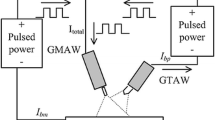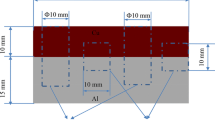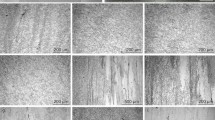Abstract
This study investigates the microstructure, electrical, corrosion, and mechanical properties of plate-shaped aluminum-copper couple produced using the explosive welding method. Mechanical tests, including hardness, tensile, tensile-shear, and impact test, concluded that the Al-Cu bimetal had an acceptable joint resistance. In this study, local intermetallic regions formed on the interface of the joint of the aluminum-copper bimetal, produced using the explosive welding technique. However, the formed intermetallic regions had no significant effect on the mechanical properties of the joint, except for increasing its hardness. According to electrical conductivity tests, the Al-Cu bimetal had an average electrical conductivity in comparison to the electrical conductivity of aluminum and copper, which were the original materials forming the joint. According to the results of electro-chemical corrosion test, during which galvanic corrosion formed, the Al side of the Al-Cu bimetal was more anodic due to its high electronegativity; as a result, it was exposed to more corrosion in comparison to the copper side.
Similar content being viewed by others
Avoid common mistakes on your manuscript.
Introduction
The welding of different metals is important due to their numerous advantages. For example, an aluminum clad copper plate is 50% lighter, and has conductivity equal to that of a copper alloy. In addition, it is 35% cheaper than a copper alloy. As a result, Al-Cu clad plates are widely used in manufacturing armored cables and yoke coils. It is difficult to join different metals using conventional fusion welding methods due to their different chemical and physical features. As a result, solid-state welding techniques attract great attention (Ref 1-12). The explosive welding technique is a solid-state welding method, and is generally used in joining or cladding different metal plates (Ref 3). This method is also known as the cold technique; however, high local temperature may form in the interface of the joint due to the dynamic of the method (Ref 4). This high temperature causes the melting on the interface, and this melting may form the intermetallic FeAl3, just like with Al-Fe joint, or the intermetallic CuAl2 and/or Cu9Al4, just like with Al-Cu joint. These intermetallics may damage the quality of the joint. Therefore, the interface properties and microstructure characterization of the bimetals are extremely important. Braunovic and Alexandrov (Ref 13) investigated the effect the intermetallic compound formed in the welded region has on electrical and mechanical properties of the Al-Cu bonding, produced using friction welding; they concluded that the contact resistance increased linearly together with an increase in thickness of the intermetallic. Xue et al. (Ref 1) comprehensively characterized the joint interface of an Al-Cu bonding, produced using friction stir welding. Cheng et al. (Ref 14) comprehensively characterized the joint interface of an Al-Cu bonding, produced using diffusion welding. Lee et al. (Ref 2) investigated the interface and mechanical properties of a laminated composite they produced from aluminum, copper, and stainless steel plates using the hot rolling process. Gulenc (Ref 11) investigated the effect explosive rates had on the explosive welding. Khosravifard and Ebrahimi (Ref 15) analyzed both theoretically and experimentally the bimetal Al-Cu produced using the extrusion process. Dyja et al. (Ref 16) analyzed both theoretically and experimentally the bimetal Al-Cu produced using the rolling process. Numerous studies are available in the literature that has analyzed properties of Al-Cu claddings or bonding produced using different production methods. However, there is no study that addresses the electrical and corrosion properties of joints that yield optimum mechanical properties (strength-ductility). In this study, a copper plate was cladded with an aluminum plate using the explosive welding technique, and the microstructure, electrical, corrosion, and mechanical properties of the clad were analyzed.
Experimental Studies
In this study, 1100 series aluminum (flyer plate) was joined to copper (base plate) produced at commercial purity using the explosive welding method. A parallel arrangement was used for the joint procedure. 90% ammonium nitrate, 4.5% fuel-oil, and 3.0% TNT were used as explosives. The explosion rate of explosives was between 3000 and 3200 ms−1. An optical microscope and a scanning electron microscope were used to conduct microstructure characterization of the produced Al-Cu bimetal. A Shimadzu HMV-2 microhardness device was used to conduct hardness measurements. A 50 g load was applied during tests. At least three measurements were taken on the same sample for each hardness value. Samples were prepared in accordance with the standard ASTM 264 (Ref 17) to identify the mechanical properties of the Al-Cu bimetal. The prepared samples were subjected to tensile and tensile-shear tests. Tensile and tensile-shear strength of the samples were determined using a ZWICK device at a load of 20 kN at deformation rate of 1 m/min at room temperature. The Charpy-impact test was used to determine the impact strength of the Al-Cu bimetal at room temperature. A SEM was used to analyze the fractured surfaces formed as a result of tensile and impact tests. At least three samples were subjected to tensile, tensile-shear, and impact tests and average of these samples was taken.
An ohm meter was used to measure the electrical conductivity of the Al-Cu bimetal. A power supply was used to create voltage between the aluminum and the copper surfaces of the bimetal, and then the current created by this supply voltage between these two surfaces was measured. The Ohm Law (R = V/I) was used to calculate the resistance of the Al-Cu bimetal.
The equation stated below was used to calculate resistivity.
where R is resistance, L is the distance of potential probes, and S is the contact area. Finally, Eq 2 was used to calculate G, conductivity.
In order to identify corrosion properties of the Al-Cu bimetal, a 1.5 mm diameter and 150 mm long copper wire was welded to the back of the Al-Cu bimetal for the purpose of enabling conductivity in the al side, copper side, and bimetal cross section (working electrode) of the bimetal, and cladded with resin, in a way to leave out only surfaces that were required to be in contact with the electrolyte. Electrochemical corrosion tests were conducted at room temperature, in a 30 g/L NaCl + 10 mL/L HCl solution, using a Gamry PC4/300 mA model potentiostat/galvanostat device.
Results and Discussion
As illustrated in Fig. 1(a), the Al-Cu bimetal produced using the explosive welding method has a plain and rough interface. There was a sharp characteristic transition at the interface where both materials bond. Figure 1(a) also illustrates locally melted regions. The high kinetic energy of the jetting, forming, and not appearing between the two plates during the collision causes the melting (Ref 18). Crossland (Ref 19) reported that the jetting forms in both the flyer and the base plates. EDS analyses conducted for this study concluded that the chemical composition of the melted region is mixture of the copper and the aluminum, which were the flyer and the base plates (Fig. 1b). According to EDS analysis, this melting region is probably CuAl2 phase. Wuhrer et al. (Ref 20) reported that the CuAl2 phase contained 68%Al and 32%Cu. Figure 2 illustrates that the region had a higher hardness in comparison to the hardness of Al and the hardness of Cu as a result of hardness measurements. Braunovic and Alexandrov (Ref 13) reported that the hardness of CuAl2 in the Al-Cu bonding, produced using the friction welding, was 413 kg/mm2. Hardness measurements also concluded that the hardness of the Al side and of the Cu side of the bimetal reduced as moving away from the joint interface due to the reduction in deformation.
Table 1 illustrates average values of the tensile test, tensile-shear test, and Charpy-impact test and standard deviation of these tests. The tensile strength of Al, and Cu forming the Al-Cu bimetal, was 110 MPa, and 220 MPa, respectively. The tensile strength of the Al-Cu bimetal, produced using the explosive welding method, was 240 MPa. The tensile strength of the bimetal increased as a result of the increased strength of Al and Cu, exposed to deformation hardening by the explosion, and due to the high strength of copper, one of components forming the bimetal. The tensile-shear strength of the Al-Cu bimetal was 140 MPa. According to the literature (Ref 12), under ideal welding conditions, the tensile-shear strength for numerous metal combinations was higher than the tensile strength of the weaker one out of the components forming the joint. There was a slight decrease in the impact strength and strain values of the Al-Cu bimetal, produced using the explosive welding method, due to the deformation hardening of Al and Cu. Figure 3(a) and (b) illustrates images of fractured surfaces belonging to the bimetal. While the Al-Cu bimetal displayed brittle fractures near the joint interface, dimples, an indicator of ductile fracture, were observed moving away from the interface.
Table 2 illustrates the electrical resistance and conductivity of the Al-Cu bimetal, calculated in accordance with Eq 1 and 2. In accordance with results parallel to those stated in the literature, the Al-Cu bimetal had an average electrical conductivity, in comparison to original aluminum and copper materials that form the joint (Ref 21-23). As concluded from microstructure results, intermetallic phases may form during production using the explosive welding method, and these phases may reduce the conductivity while increasing the resistance. Cheng et al (Ref 14) and Abbasi et al. (Ref 24) reported that the conductivity decreased as the thickness of intermetallic compounds increased. In this study, the CuAl2 phase that formed in small quantities (inconsistent) in different regions had no adverse effect on the electrical conductivity of the Al-Cu bimetal.
Figure 4 illustrates the polarization curves of the Al-Cu bimetal, and the polarization curves of Al and Cu forming the bimetal. The corrosion current density (I corr) and corrosion potential were eliminated from the curve and presented in Table 3. According to polarization results, while the E corr of Cu was higher than the E corr of Al and Al-Cu bimetal, the I corr of Al and Al-Cu bimetal was higher than the I corr of Cu. According to the activity and passivity properties of Al and Cu in sea water, Al was exposed to severe corrosion; the results were parallel to those stated in the literature (Ref 25). In addition, there was galvanic corrosion in the Al-Cu bimetal, and as illustrated in Figure 5, Al acted as anodic because of its high electronegativity.
Conclusions
Stated below are conclusions reached after analyzing the microstructure, mechanical, electrical, and corrosion properties of the Al-Cu bimetal, produced using the explosive welding method.
-
1.
The Al-Cu bimetal display an interface that is both plane and rough, and also has partially an intermetallic phase known as CuAl2.
-
2.
Tensile, tensile-shear, and impact test results concluded that the Al-Cu bimetal has an acceptable strength.
-
3.
There was no decrease in electrical conductivity, in spite of the intermetallic phase on the joint interface.
-
4.
Galvanic corrosion occurred during corrosion tests, and the Al side of the bimetal was exposed to more corrosion than the copper side.
References
P. Xue, B.L. Xiao, D.R. Ni, and Z.Y. Ma, Enhanced Mechanical Properties of Friction Stir Welded Dissimilar Al-Cu Joint by Intermetallic Compounds, Mater. Sci. Eng. A, 2010, 527, p 5723–5727
J.E. Lee, D.H. Baea, W.S. Chunga, K.H. Kima, J.H. Lee, and Y.R. Choa, Effects of Annealing on the Mechanical and Interface Properties of Stainless Steel/Aluminum/Copper Clad-Metal Sheets, J. Mater. Process. Technol., 2007, 187–188, p 546–549
S.A.A. Akbari-Mousavi, L.M. Barrett, and S.T.S. Al-Hassani, Explosive Welding of Metal Plates, J. Mater. Process. Technol., 2008, 202, p 224–239
M. Acarer, B. Gulenc, and F. Findik, Investigation of Explosive Welding Parameters and Their Effects on Microhardness and Shear Strength, Mater. Des., 2003, 24, p 659–664
B. Wronka, Testing of Explosive Welding and Welded Joints—Wavy Character of the Process and Joint Quality, Int. J. Impact Eng., 2011, 38, p 309–313
F. Findik, Recent Developments in Explosive Welding, Mater. Des., 2011, 32, p 1081–1093
Y. Wang, H.G. Beom, M. Sun, and S. Lin, Numerical Simulation of Explosive Welding Using the Material Point Method, Int. J. Impact Eng., 2011, 38, p 51–60
N. Kahraman and B. Gulenc, Microstructural and Mechanical Properties of Cu-Ti Plates Bonded Through Explosive Welding Process, J. Mater. Process. Technol., 2005, 169, p 67–71
N. Kahraman, B. Gulenc, and F. Findik, Joining of Titanium/Stainless Steel by Explosive Welding and Effect on Interface, J. Mater. Process. Technol., 2005, 169, p 127–133
H.H. Yan and X.J. Li, Strain Rate Distribution Near Welding Interface for Different Collision Angles in Explosive Welding, Int. J. Impact Eng., 2008, 35, p 3–9
B. Gulenc, Investigation of Interface Properties and Weldability of Aluminum and Copper Plates by Explosive Welding Method, Mater. Des., 2008, 29, p 275–278
M. Acarer and B. Demir, An Investigation of Mechanical and Metallurgical Properties of Explosive Welded Aluminum-Dual Phase Steel, Mater. Lett., 2008, 62, p 4158–4160
M. Braunovic and N. Alexandrov, Intermetallic Compounds at Aluminum-to-Copper Electrical Interfaces: Effect of Temperature and Electric Current, IEEE Trans. Compon. Packag. Manuf. Technol. A, 1994, 17, p 78–85
X.-L. Cheng, B.-X. Bai, Y.-M. Gao, and C. Feng, Microstructural Characterization of the Al/Cu/Steel Diffusion Bonded Joint, Rare Met., 2009, 28, p 478–481
A. Khosravifard and R. Ebrahimi, Investigation of Parameters Affecting Interface Strength in Al/Cu Clad Bimetal Rod Extrusion Process, Mater. Des., 2010, 31, p 493–499
H. Dyja, S. Mróz, and A. Milenin, Theoretical and Experimental Analysis of the Rolling Process of Bimetallic Rods Cu-Steel and Cu-Al, J. Mater. Process. Technol., 2004, 153, p 100–107
Standard Specification for Stainless Chromium-Nickel Steel-Clad Plate, Sheet, and Strip A 264, ASTM, p 66–73
K. Hokomato, T. Izuma, and T. Fujita, Metallurg. Trans. A, 1993, 24, p 2289–2297
B. Crossland, Explosive Welding of Metals and its Application, Clarendon Press, Oxford, 1982, p 26–29
R. Wuhrer, M. Lee, K. Moran, and W.Y. Yeung, X-Ray Mapping of Metallic Elements in Roll Bonded Metal Laminates, Mater. Forum, 2006, 30, p 225–232
S. Raymond, Principles of Physics, 2nd ed., Saunders College Publishing, London, 1998, p 602–606
D. Griffiths, Introduction to Electrodynamics, 3rd ed., Upper Saddle River, Prentice Hall, NJ, 1999, p 285–286
C. Macchioni, J.A. Rayne, and C.L. Bauer, Low Temperature Resistivity of Bulk Copper-Aluminum Alloys, Phys. Rev. B, 1982, 25, p 3865–3870
M. Abbasia, A. Karimi Taherib, and M.T. Salehia, Growth Rate of Intermetallic Compounds in Al/Cu Bimetal Produced by Cold Roll Welding Process, J. Alloys Compd., 2001, 319, p 233–241
R. Francis, Bimetallic Corrosion, National Physical Laboratory, Middlesex, 2000, p 3–13
Author information
Authors and Affiliations
Corresponding author
Rights and permissions
About this article
Cite this article
Acarer, M. Electrical, Corrosion, and Mechanical Properties of Aluminum-Copper Joints Produced by Explosive Welding. J. of Materi Eng and Perform 21, 2375–2379 (2012). https://doi.org/10.1007/s11665-012-0203-6
Received:
Revised:
Published:
Issue Date:
DOI: https://doi.org/10.1007/s11665-012-0203-6









